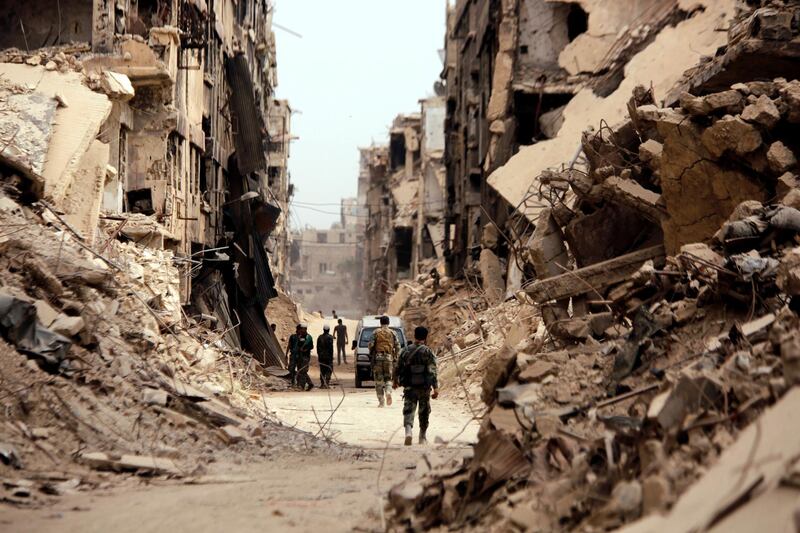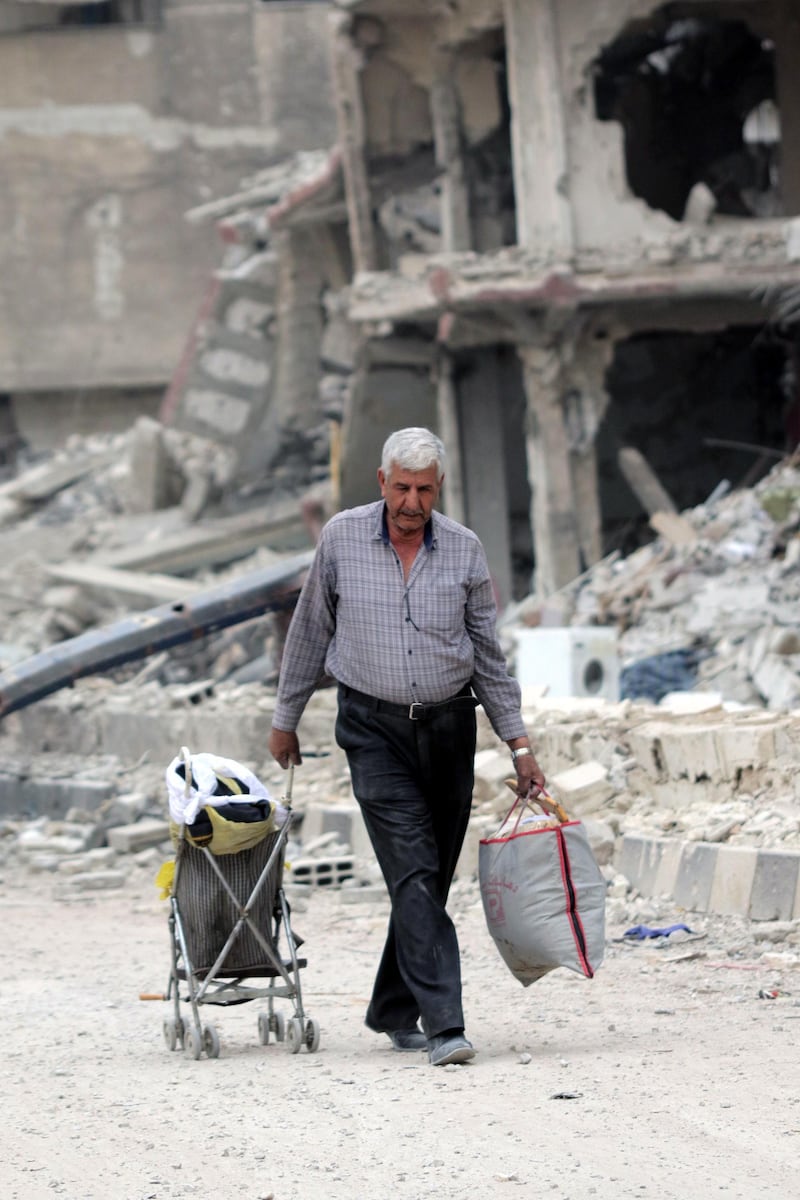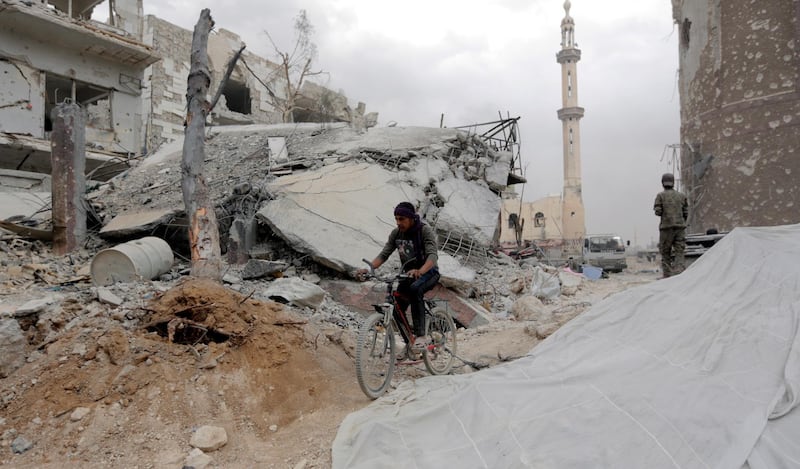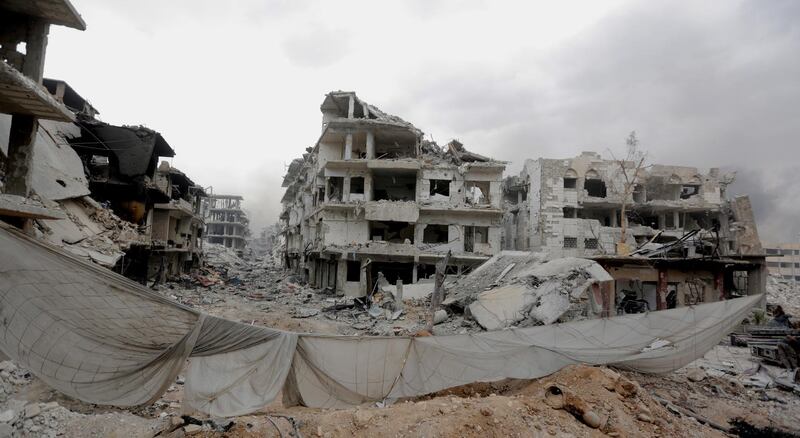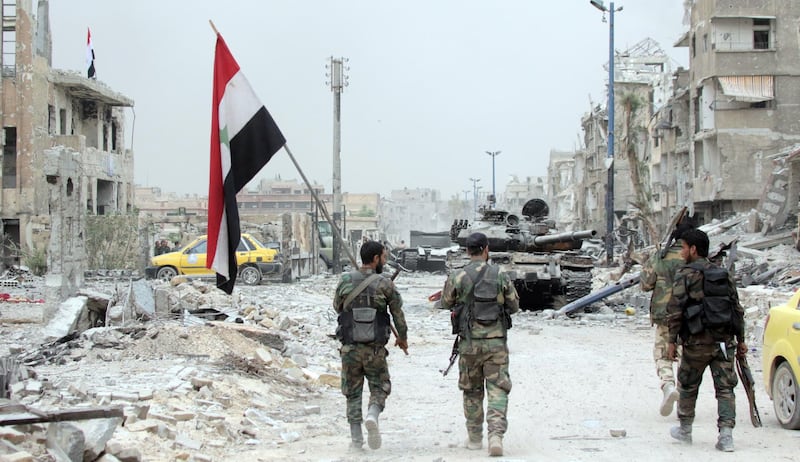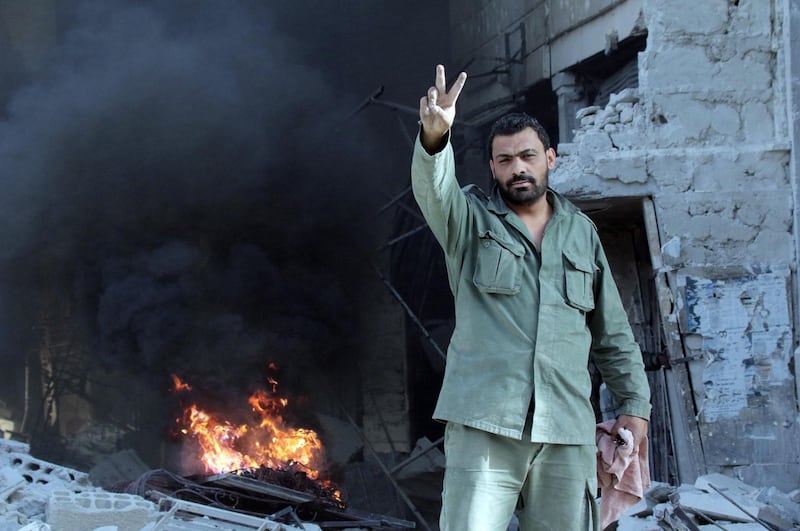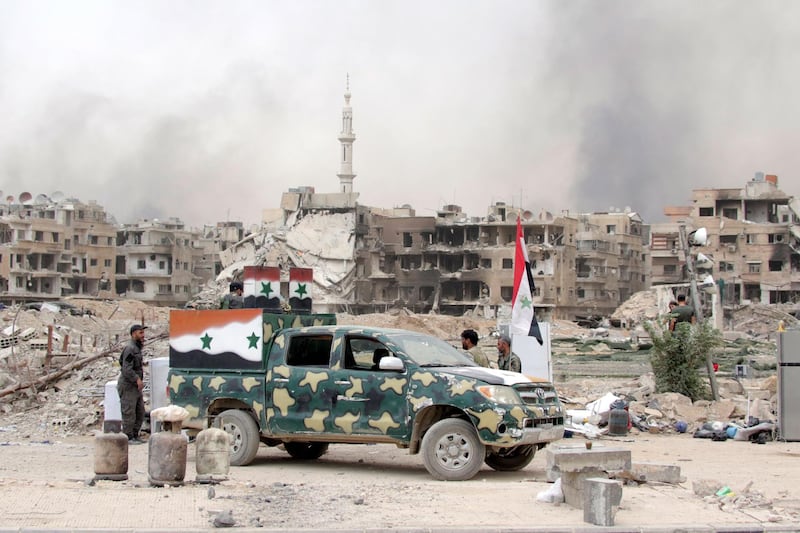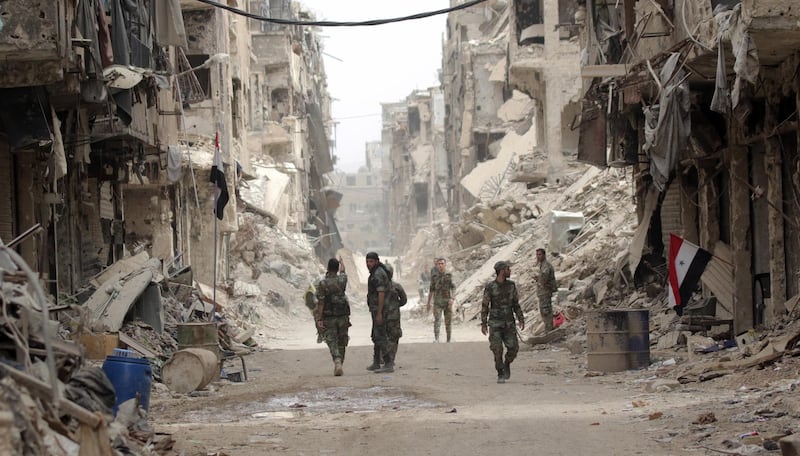The black flags of the Islamic State have been torn down and the dust from artillery-strikes has settled, but most of the once bustling Palestinian refugee camp of 160,000 people on the edge of Syria's capital is now a ramshackle of blown out apartment blocks.
Yarmouk, the culturally and historically important camp in south Damascus, now stands in ruins.
The end of a Syrian government offensive against ISIS fighters on Monday has seen former residents of Yarmouk camp start to return to seek out their homes – or what remains of them – for the first time in years.
"We kept walking and walking, not knowing where we were, other than that we were on Palestine Street. All the buildings and shops were either on the ground or mostly destroyed," said Omar, describing one of the main streets of Yarmouk that this week led himself and his father back to the family home he has not seen since February 2013.
"When we reached the street where my family's building is, finally I saw some buildings still standing. I started to walk super carefully, looking up, until I saw the corner of my house and said to myself, 'At least it's standing'."
"There were no landmarks, nothing to tell you where you were standing," Omar said. "If you closed your eyes and someone brought you there, you wouldn't be able to tell if you were in Yarmouk, Daraya or any other destroyed area [of Syria]."
Others were less fortunate. Former residents now forced into the diaspora must scour the hundreds of images shared over Facebook by pro-government fighters, photojournalists and returning residents to try and assess the damage, to learn what has been lost.
Abdullah, who has been living in Sweden since 2013 after being displaced from Yarmouk, received videos from a relative of the broken masonry and bare concrete-walls inside what was once the family home. "It destroyed me," Abdullah said. "I felt like a huge chunk of my dreams and memories had been destroyed in front of my eyes."
Since April 19, the Syrian Army and a joint force of Syrian and pro-regime Palestinian militias have been fighting a gruelling offensive against the final pockets of ISIS in the capital. That ended this week, after more than a month of bombardments and displacements, as the last remaining ISIS fighters were bussed out towards the east as part of a settlement deal.
______________
Read more
Syrian regime declares Damascus fully secure
Syria crisis: Rebels withdraw from last holdout
[ Syria police deploy in south Damascus after ISIS defeat ]
______________
Prior to the departure of the ISIS at least 9,000 fighters, civilians and Palestinian refugees left the last remaining rebel-held suburbs just next to Yarmouk to be taken to northern Syria.
Even before the last offensive, the situation in the camp was dire. Hundreds of thousands of internationally displaced people took shelter in Yarmouk in the early days of the uprising before it was bombarded by the Syrian Air Force and then stormed by rebel groups in December 2012. Many fled, before a crippling siege imposed by pro-government forces in mid-2013 left remaining residents starving on the doorsteps of Damascus and cut off from the outside world. ISIS took control of most of Yarmouk in April 2015.
This week marked the first time in seven long years, since the beginning of the country’s uprising and conflict, that the Syrian government has been in total control of the capital. But that has come at a significant cost for Yarmouk.
"What we've seen is the total destruction of what was once one of the largest and most thriving Palestinian communities in the Middle East," UN refugee agency for Palestinians spokesman Chris Gunness told The National. "The significance of this the week after the 70th anniversary of the so-called Nakba, the original catastrophe of the Palestinians, should not be overlooked."
Between 100 to 200, mostly elderly or infirm, civilians stayed on inside Yarmouk throughout the offensive while at least 6,000 were forced to flee to nearby rebel areas. London-based monitor, Action Group for Palestinians of Syria, counts at least 21 Palestinian civilians killed. That number could be higher amid concerns that some residents were simply buried under rubble during the month-long offensive.
Since the end of the fighting, there have been widespread reports of looting of empty homes by regime forces – fridges and furniture turned into spoils of war. This has angered former residents as well as government supporters.
On returning to his home this week, Omar recounted seeing "men in military uniforms everywhere carrying fridges, washing-machines, and anything else they could carry." Even one politician from a prominent pro-government Palestinian faction in Damascus criticised the looting homes this week when writing on his Facebook page, “Are we returning to the camp or not? Leave people their memories [in the camp]. We may have been happy to defeat terrorism…but we need a solution. We want to return to Yarmouk.”
Ibrahim, a Palestinian IDP residing in Damascus who is broadly supportive of the Syrian government, has been waiting to go home since fleeing the camp in December 2012.
"Of course there's destruction, massive destruction. Nobody is denying that," he said. "Since the camp was liberated I revisited Yarmouk and saw the destruction with my own eyes."
"But people need to have hope. We can rebuild the camp again; the most important thing is the people of Yarmouk. They built the camp by themselves before and they can rebuild it again."
Not everyone shares his optimism. "Nothing will be a replacement of the past because the past has been ugly," said Palestinian-Syrian refugee Kotada Younis, who also now lives in Sweden. "A lot of people have died. [So] it will never be the same even if we go back to the same buildings. It won’t be Yarmouk as it was before...[or] a replacement of what people there lost - friends, sons, families, childhood memories with the people that have died.”
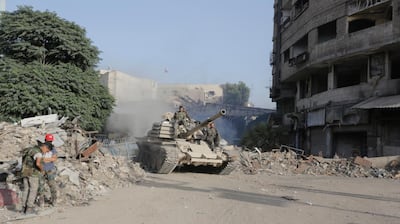
There has been no formal assessment of the damage done to Yarmouk yet.
Wesam Sabaaneh, director of the Jafra Foundation, a humanitarian organisation that works in Palestinian camps and communities within Syria, revisited areas of northern Yarmouk to witness first-hand the “massive destruction… mostly caused by the military operation that was launched against [ISIS] terrorists in Yarmouk camp.”
However, he said, pockets of northern and central Yarmouk appeared not to be as badly affected. "There is destruction and so on… but [in those areas] there are still many buildings standing. There’s the possibility that with a little reconstruction… people will be able to go back there.”
The Palestine Liberation Organisation (PLO) has repeatedly promised that the reconstruction of Yarmouk would begin once all militants had left. And earlier this week, the PLO’s chief representative in Damascus, Anwar Abdel Hadi, told AFP that the “next step after liberation” would be “combing the area, removing rubble and assessing the damage to rebuild and bring infrastructure back so civilians can return.”
Mr Abdel Hadi claimed that discussions over a reconstruction plan for Yarmouk were already under way with United Nations Relief and Works Agency.
However, speaking on Tuesday, Mr Gunness “[denied] on the record that there are any discussions between UNRWA and the PLO on reconstruction.”
“It is far too early to talk about reconstruction,” he said. “We need to deal with the immediate needs of the people of Yarmouk; feeding them, finding accommodation and dealing with health issues.”
In the meantime, Palestinian refugees from Yarmouk and Syria’s other Palestinian camps will likely face legal barriers to return on top of the war-time destruction of homes and infrastructure.
Law 10, passed this year, and Law 11, passed in 2011, target real estate rights. Together, the two laws will make it harder for Palestinian-Syrians to maintain, or prove, property rights.
With all the fighting, many families may simply have lost the various documents required to prove ownership of their own little piece of Yarmouk. In doing so, many have perhaps lost their other right of return and the widespread destruction of Yarmouk risks creating a new generation of Palestinian refugees displaced - and possibly denied return - once again.
